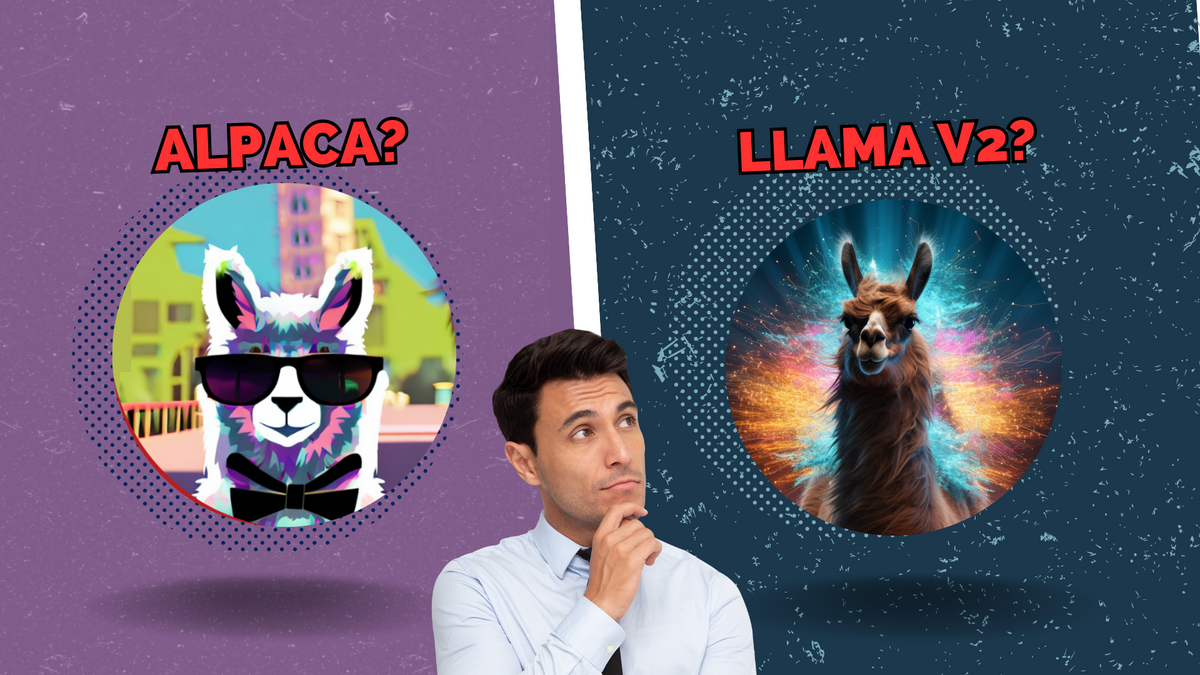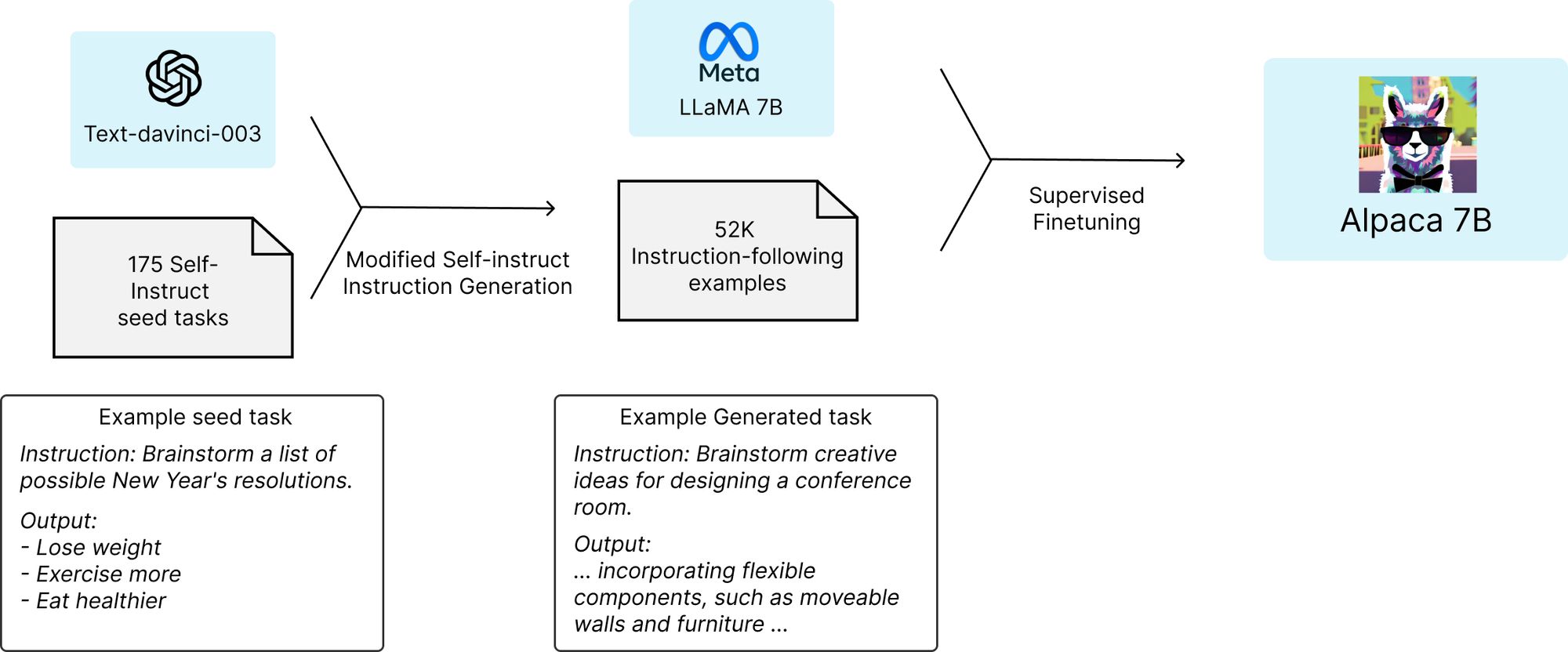LLaMA-v2-Chat vs Alpaca: When should you use each AI model?
When should you use LLaMA-v2-chat vs Alpaca? What are the pros and cons of both AI models?

LLMs have revolutionized tons of aspects of our lives, from language generation to image captioning software to friendly chatbots. These AI models provide powerful tools for solving real-world problems, such as generating chat responses or following complex instructions. In this blog post, part of a series on LLaMA v2, we will compare two popular AI models: llama13b-v2-chat and Alpaca, and explore their features, use cases, and limitations.
Subscribe or follow me on Twitter for more content like this!
We'll also see how we can use AIModels.fyi to find similar models and compare them to llama13b-v2-chat and Alpaca. Let's begin.
About the LLaMA13b-v2-chat Model
The llama13b-v2-chat model is a fine-tuned version of the 13-billion-parameter LLaMA-v2 language model original developed by Meta. It has been fine-tuned specifically for chat completions, making it an excellent tool for generating chat responses to user messages. You can find detailed information about the model on the llama13b-v2-chat creator page and the llama13b-v2-chat model detail page.
This language model is designed to assist in generating text-based responses for chat-based interactions. Whether it's providing customer support, generating conversational agents, or assisting in natural language understanding tasks, llama13b-v2-chat can be a valuable tool. Its large parameter size enables it to capture complex language patterns and generate coherent and contextually relevant responses.
In summary, llama13b-v2-chat can understand inputs and generate appropriate chat responses.
Understanding the Inputs and Outputs of the llama13b-v2-chat Model
To effectively use the llama13b-v2-chat model, it's essential to understand its inputs and outputs. The model accepts the following inputs:
- Prompt: A string representing the chat prompt or query.
- Max Length: An integer specifying the maximum number of tokens to generate.
- Temperature: A number that adjusts the randomness of outputs. Higher values (greater than 1) result in more random responses, while lower values (closer to 0) produce more deterministic outputs.
- Top P: When decoding text, samples from the top p percentage of the most likely tokens. Lower values limit the sampling to more likely tokens.
- Repetition Penalty: A number that penalizes the repetition of words in generated text. Higher values discourage repetition, while values less than 1 encourage it.
- Debug: A boolean flag to provide debugging output in logs.
The model processes these inputs and generates a list of strings as output, representing the generated chat responses. The schema for the output is a JSON array containing strings. You can find out more about this model in the guides here and here.
About the Alpaca Model
The Alpaca model is an instruction-following language model fine-tuned from the LLaMA 7B model on 52K instruction-following demonstrations. It was developed by the Stanford Center for Research on Foundation Models (CRFM). The creators of Alpaca are Rohan Taori, Ishaan Gulrajani, Tianyi Zhang, Yann Dubois, Xuechen Li, Carlos Guestrin, Percy Liang, and Tatsunori B. Hashimoto. You can find detailed information about the model on the Stanford page the team created.
The Alpaca model focuses on instruction-following capabilities and aims to bridge the gap between research and industry by providing an accessible instruction-following language model for academic purposes. It is fine-tuned from the LLaMA 7B model using a dataset of 52K instruction-following demonstrations, generated in the style of self-instruct using text-davinci-003. The model demonstrates promising performance in single-turn instruction following.
This model's release is intended to facilitate academic research and foster improvements in instruction-following models. It is important to note that Alpaca is not designed for commercial use, and its safety measures are not fully developed for general deployment.
In summary, Alpaca offers a lightweight and reproducible instruction-following language model that can be utilized for research purposes and the exploration of instruction-following scenarios.

Understanding the Inputs and Outputs of the Alpaca Model
To effectively utilize the Alpaca model, let's explore its inputs and outputs.
As an instruction-following model, Alpaca follows instructions and generates responses based on the given instructions.
The inputs to Alpaca are represented by the instructions themselves, which describe the tasks the model should perform. Alpaca also has an optional input field, providing additional context or input for the task.
The outputs of the Alpaca model are the generated responses to the given instructions. The responses are generated based on the fine-tuned model's understanding of the task and the underlying language patterns learned during training. You can read more about this in the model's README on Github.
Comparing and Contrasting the Models
Now that we have explored the llama13b-v2-chat model and the Alpaca model in detail, let's compare and contrast them to understand their similarities, differences, and optimal use cases.
LLaMA13-v2 vs Alpaca
Both the llama13b-v2-chat and Alpaca models are fine-tuned language models designed for different purposes. While llama13b-v2-chat focuses on chat completions, Alpaca specializes in instruction-following tasks.
Use Cases
The llama13b-v2-chat model is suitable for a wide range of chat completion tasks. It can be utilized in customer service applications, chatbot development, dialogue generation, and interactive conversational systems. This model's versatility allows it to generate coherent and contextually relevant responses to user queries or prompts.
On the other hand, the Alpaca model is specifically tailored for instruction-following tasks. It excels at understanding and executing instructions provided by users, making it ideal for applications such as virtual assistants, task automation, and step-by-step guidance systems. Alpaca's ability to comprehend and follow instructions makes it a valuable tool for users seeking assistance in performing various tasks.
Pros and Cons
The llama13b-v2-chat model's strengths lie in its large parameter size (13 billion) and its fine-tuning for chat completions. It can generate detailed and contextually appropriate responses, making it useful for engaging and interactive conversational experiences. However, due to its generic nature, the model might occasionally produce responses that are factually incorrect or propagate stereotypes. Careful monitoring and filtering mechanisms should be implemented to mitigate these risks.
Alpaca, on the other hand, offers a smaller and more cost-effective model (7B parameters) that is specifically optimized for instruction-following. It demonstrates performance comparable to the text-davinci-003 model in this domain. Alpaca's relative ease of reproducibility and lower cost make it an attractive option for academic researchers interested in instruction-following models. However, it shares common limitations of language models, including occasional hallucination and the potential to generate false or misleading information.
Similarities
Both models are built upon the LLaMA framework, which provides a strong base language model for fine-tuning. They leverage the power of large-scale language models to generate high-quality outputs. Additionally, both models have been evaluated and compared to the text-davinci-003 model, showcasing their ability to perform similarly in instruction-following tasks.
Differences
The primary difference between the models lies in their intended use cases and specialties. While llama13b-v2-chat is a versatile chat completion model suitable for various conversational applications, Alpaca is specifically designed for instruction-following tasks. Alpaca's training data is generated based on self-instructed prompts, enabling it to comprehend and execute specific instructions effectively.
Optimal Use Cases
Choosing between the llama13b-v2-chat and Alpaca models depends on the specific requirements of your project or application. If your goal is to develop a conversational system or chatbot that engages in dynamic and context-aware conversations, llama13b-v2-chat would be a better choice. On the other hand, if you need a model that can understand and execute user instructions for task-oriented applications, Alpaca is the more suitable option.
Taking it Further - Finding Other Instruction-Following or Chat Models with AIModels.fyi
If you're interested in exploring additional instruction-following models beyond Alpaca, AIModels.fyi is a valuable resource. It offers a comprehensive database of AI models, including those catered to instruction-following tasks. By following these steps, you can discover similar models and compare their outputs:
Step 1: Visit AIModels.fyi
Head over to AIModels.fyi to begin your search for instruction-following models.
Step 2: Use the Search Bar
Utilize the search bar at the top of the page to enter specific keywords related to instruction-following models. This will provide you with a list of models relevant to your search query.
Step 3: Filter the Results
On the left side of the search results page, you'll find various filters to narrow down the models. You can filter and sort by model type, cost, popularity, and specific creators. Apply these filters to find models that align with your requirements.
By leveraging the search and filter features on AIModels.fyi, you can find models that best suit your needs and explore the diverse landscape of instruction-following models.
Conclusion
In this comparison, we explored the llama13b-v2-chat and Alpaca models in terms of their use cases, pros and cons, similarities, differences, and optimal applications. We emphasized the versatility of llama13b-v2-chat for chat completions and the specialization of Alpaca for instruction-following tasks. AIModels.fyi serves as a valuable resource for discovering and comparing various AI models, including instruction-following models. We hope this guide inspires you to explore the creative possibilities of AI and encourages you to leverage AIModels.fyi to find models that align with your specific needs.
Remember to subscribe for more tutorials, updates on new AI models, and a wealth of inspiration for your next creative project. Happy exploring and enhancing your AI-powered endeavors with AIModels.fyi!
Subscribe or follow me on Twitter for more content like this!




Comments ()